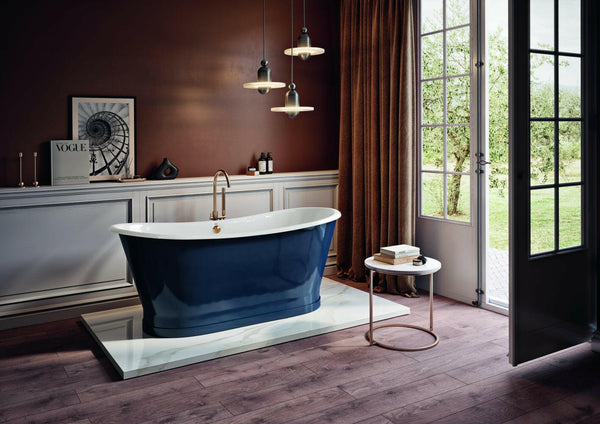From boosting a home’s value to improving luxury appeal, sinks and faucets make for a powerful duo. And finding the right pair can take a remodel from drab to fab with just a little forethought and planning.
But what’s the right faucet for that trendy new sink? And how do you know it’ll match the rest of the bathroom? Here’s how to find a bathroom sink and faucet pairing that wows both homeowners and guests.
Consider the Whole Bathroom
Nashville-based interior designer Deborah Burnett explains that during a remodel, one new element often dictates another element. For example, if a new granite countertop or a clawfoot tub have already been decided on, these elements will frame which sinks and faucets are used.
In fact, Bath Express says that this is one of the most common mistakes they see. Since different companies can have the same name for slightly different colors (especially in the white and beige families) it’s especially important to match swatches before diving into a project. This will ensure a seamless look across the tub, shower, sink and more.
To ensure consistency across a bathroom’s fixtures, consider landing on one finish for all pulls, faucets, handles and towel bars. Interior designer Merri Cvetan suggests choosing a vibrant brushed nickel, for example, which coordinates with a variety of other silver finishes in a bathroom.
Faucet Considerations
From the finish to the handles, a faucet has many different features worth considering.
While faucets with one handle provide easier temperature control, the more traditional two-faucet style can work well in a bathroom. The Happy Housie suggests the option of two handles for a couple of reasons: people don’t tend to use their bathroom sinks as much as their kitchen sinks; and it’s still easy to make water temperature adjustments.
Remember to think about how far back the handle reaches in relation to the wall. The bridge behind the sink should be far enough away from it so that the handles don’t touch the wall.

Faucet functionality is another thing to consider when choosing a faucet. House, Inc. explains that if someone has children, they might want a faucet that turns off automatically. If someone is going to have elderly parents staying with them, having an ADA accessible faucet is a smart idea. If these considerations are more important to someone than having a stylish sink, think about helping them choose a faucet first.
Another consideration is how much traffic the bathroom is going to have. RFMC says that it’s a good idea to consider daily life and routines – and how much use the faucet might get. They add that a stylish faucet might be good for a guest bathroom and a more functional design might be better for a high traffic faucet.
If a customer has already chosen a sink, they’ll need to think about which faucet suits it best. And this isn’t something based on aesthetics alone – there are certain faucets that just don’t work with certain sink designs. For example, Waterhouse Bath and Kitchen Studio manager Dion Wilson explains that people always need to account for the height of the faucet above the sink and the sink’s length. If there’s not enough room in this space, people won’t have room to wash their hands comfortably. And if there’s too much space here, they might end up with a serious splashing problem.
Faucet and Sink Styles
Once the customer has thought about what they’re looking for in a faucet and sink, it’s time to consider which styles will work best with the rest of the bathroom. Bell Plumbing explains that a center set faucet is the most standard, with one handle for hot, one for cold, and the faucet in the middle. There’s also a single hole faucet, which combines the faucet and lever in a single unit.
And with so many sink styles available today, it’s important to consider all of available options. Angie Hicks of Angie’s List says that there are five main types of sinks that most remodelers choose. These include drop-in, undermount, one-piece, vessel and wall mounted.

Vessel and Undermount Sinks
With the types of sinks in mind, take note of the different materials that common bathroom sinks come in and how they might match other bathroom elements. F-W-S Countertops says that vessel sinks are one of the most versatile options. From glass and hammered bronze to marble and copper, vessel sinks can be found in almost any finish. If they’re looking to maximize space and storage, vessel sinks can also be placed on top of a counter. New Century Marble & Granite shows how pairing a vessel sink with a wall mount faucet is an additional way to conserve space.
As for other sink style benefits, HD Supply explains that undermount sinks are mounted below the countertop for a sleek look, with no rim so it’s easy to clean. Another benefit of undermount sinks is that they provide more counter space. Mansfield Plumbing adds that they draw attention to the counter itself, so this option might work when trying to emphasize a granite or marble top.
Pedestal Sinks
Alternatively, pedestal sinks provide a much more classic feel that’s perfect for an older home in a Victorian or farmhouse style. All About Bathrooms says that pedestal sinks are a solid choice for small bathrooms, where space is at a premium. Half baths and guest bathrooms are often the perfect place for pedestal sinks, where there’s less room. Decorator Thom Filicia explains that the one downside to the pedestal, however, is lack of storage.
It’s common to be faced with form vs. function conflicts when remodeling a bathroom, and considering values and priorities from the start can help guide these decisions.
Images by: Fancycrave, ErikaWittlieb, Semevent







